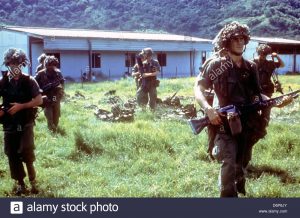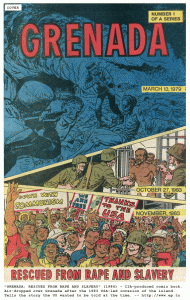What actually happened to the American Medicial Students?
By: Dana Marecheau
Dr. Merle Collins, now a professor at the University of Maryland, was heavily involved in the Grenadian Revolution. She is most known for working within the Grenadian Government as the Coordinator of Research on Latin America and the Caribbean. She later left Grenada in 1983, the same year of the American Intervention.[1] During our interview, Dr. Collins mentions, “People [general public of Grenada] were less concerned with ideological discussions [by the Coard / Bishop factions] than with the everyday rewards they could see – more access to education, more scholarships for their children, whether those scholarships were in Cuba, Britain, India or the Soviet Union. Today there are many excellent doctors and civil service personnel in Grenada, trained in Cuba during that period of radicalization”.[2] This sparked my interest considering that H.W. Brands in his book, American Dreams, mentions that the U.S feared the growing relationship between Grenada, Cuba, and the Soviet Union. This was triggered by the construction of an “unusually long runway, one suitable for heavy Soviet transport or tourist-filled airliners [as Bishop rejoined]”.[3] Brands provides the reader with minimal details about the events prior to and after the American Invasion. Further intrigued by lack of details H.W. Brands provides and Dr. Collins’ comment, I went on to interview Rubert Bishop. His memories of the American Intervention, provides additional information that challenges the accounts publicized by the American government.
Rubert Bishop worked at the Grenada Prison Service as a prison guard. During his time as a prison guard, Maurice Bishop was the prime mister. Rubert recalled his rise to political power; to him the most memorable televised speech made by Maurice Bishop was one regarding education reform. Rubert describes Maurice Bishop as a “dynamic speaker”, then he exclaimed, “The tone of speech, and so on, the fluency in speech, and the knowledge of the topics were remarkable! He was one of the best I have ever heard”.[4] On March 13, 1979, Maurice Bishop seized power with the support of the New Jewel Movement.[5] When the U.S. refused to provide aid for military defense and offered only limited economic assistance, Maurice Bishop sought out help from other countries, Cuba being one of them. [6] The U.S. viewed this act as threatening, but to Rubert, Maurice Bishop was concerned about developing his country and would take assistance from anyone to do just that.[7]
Brands mentions that “Maurice Bishop had cultivated warm relations with Cuba”,[8] but the objective of this relationship was misconstrued. Maurice Bishop and his party implemented socialist programs on the island, and he continued to receive support from Cuba. One result of this program included the increase in the literacy rate, which went from 85%, to about 98%.[9] While working at the prison, Rubert facilitated a literacy program for prisoners that aided in the increase of literacy rates in Grenada. The supplies utilized in this literacy program, which consisted of books and other education tools, were provided by Cuba. Rubert remembers how impressed he was by one prisoner who took advantage of the opportunity to receive his “old levels”- an equivalate to a high school degree. Rubert said, “We were able to get the papers for him to study, and take the test, and so on”. [10] Cuba’s generosity did not stop there, they contributed about 500 Cuban airport workers, advisors on every aspect of society, culture and technology, doctors who treated about half of the Grenadian population and trained Grenadians to become doctors, and over 200 scholarships to Grenadians to study in Cuba.[11] Rubert Bishop felt the direct impact of this because he accepted a scholarship to study prison administration in Cuba. [12]
The construction of a new airport caught the U. S’s attention as Ronald Reagan cited an extra-long, military-aircraft-friendly runway. This was later used to justify the American Intervention.[13] Rubert strongly disagreed with the U. S’s assumption; “they [the U.S.] also were saying they [Grenada] was building a military base… this was not true at all! Grenadians were excited to have a new airport because we didn’t have an international airport. At the time, we only had this small airport in Grenville… it was called Pearls Airport. I remember Maurice Bishop use to speak about wanting bigger planes to come. That was one of his primary goals to get that airport, and he did get assistance from the Cubans to come build that airport. The air strip was completed at the time of the intervention”. [14] Rubert’s account of this highlights the how the U.S misinterprets Cuba’s assistance. Overall, the U.S thought that Cuba was assisting Grenada in developing and increasing its militarization, but this was not the case.
Then, on October 19, 1983, Bernard Coard, placed Maurice Bishop and other moderates under arrest. During a protest by people who supported Maurice Bishop, army troops massacred dozens of protesters, executed Bishop and two other cabinet members.[15] On the day of Maurice Bishop’s assignation, Rubert Bishop recalls working in the prison. Since the prison, he worked at was located on a high hill, he could look down at Fort Rupert. Hearing all the commotion from the prison, Rubert grabbed a binocular to see soldiers shooting through the crowd; “I remember seeing a gap between the crowd indicating that bullets were going through that area”. [16] Reagan administration feared that the chaos, threatened the medical students studying at a university in St. Georges.[17] But again Rubert claimed the U.S. exaggerated this; “The truth is the whole thing was distorted…at no time were the students at risk. Matter of fact there had soldiers ensuring their safety… yes, they had Grenadian soldiers ensuring their safety. We were surprised that American said that they were at risk… no one was attacking them there was nothing like that… that was definitely a lie!”[18]

US 82nd Airborne Division soldiers during the Invasion of Grenada, code named Operation Urgent Fury October 25, 1983 in St Georges, Grenada
Lastly, on November 25th, 1983, Coard’s government collapsed and was replaced by one the U.S. deemed as acceptable[19], Additional Brands supports this notion as he says, “the White House claimed a victory for freedom and helped a conservative successor government clean up the mess the invasion cause”. [21] But according to Bishop, the successor that was put into power did the opposite, and Rubert Bishop did not anticipate the long-term repercussions that were to come. Rubert Bishop recounts, “Right after the intervention what the American did … they [United States] put the GMP in place to run the country. He was not progressive, neither was he interested in the development of the country. They were actual installed after the Intervention and they actually brought down the country!… a lot of people did not like them”[20].
Overall, Rubert Bishop’s accounts of events before and after the American Intervention adds to the narrative Brands creates in his book, American Dreams. In addition, both Brands and Rubert distinctive perceptions, create a well-rounded remembrance of the American Intervention in Grenada. From Rubert Bishop’s point of view, as a citizen of Grenada, the American Intervention further perpetuated the decline of the country economically, especially as the U.S. appointed a political figure that did not have the countries’ interest in mind. One the other hand, the U.S. views the Grenadian Intervention as victory in their attempts to fight against communism. In fear that communist countries like the Soviet Union and Cuba were trying to expand and manifest their power, the U.S. was trying to prevent this.
Works Cited:
[1]Peepal Tree Press. “Merle Collins.” Merle Collins | Peepal Tree Press. Accessed April 23, 2017. http://www.peepaltreepress.com/authors/merle-collins.
[2] Interview with Professor Merle Collins (email), April 1st, 2017
[3] Brands, H. W. American Dreams: The United States since 1945. New York: Penguin Books, 2011. (247)
[4] Interview with Rubert Bishop (phone conversation), April 18th, 2017
[5] Zunes, Stephen. “Global Policy Forum.” The US Invasion of Grenada. October 2003. Accessed April 26, 2017. https://www.globalpolicy.org/component/content/article/155/25966.html.
[6] Zunes, Stephen. The US Invasion of Grenada
[7] Interview with Rubert Bishop (phone conversation), April 18th, 2017
[8] Brands, H. W. American Dreams: The United States since 1945 (247)
[9] Zunes, Stephen. The US Invasion of Grenada
[10] Interview with Rubert Bishop (phone conversation), April 18th, 2017
[11] Puri, Shalini. Grenada revolution in the Caribbean Present. Place of publication not identified: Palgrave Macmillan, 2016. (177)
[12] Interview with Rubert Bishop (phone conversation), April 18th, 2017
[13] “1943 Pearls Airport: Grenada’s First Airport.” Caribbean Aviation. November 19, 2016. Accessed April 26, 2017. https://caribaviation.net/2016/07/22/1943-pearls-airport/.
[14] Interview with Rubert Bishop (phone conversation), April 18th, 2017
[15] Zunes, Stephen. The US Invasion of Grenada. October 2003
[16] Interview with Rubert Bishop (phone conversation), April 18th, 2017
[17] Zunes, Stephen. The US Invasion of Grenada. October 2003
[18] Interview with Rubert Bishop (phone conversation), April 18th, 2017
[19] “United States invades Grenada.” History.com. Accessed April 26, 2017. http://www.history.com/this-day-in-history/united-states-invades-grenada.
[20] Interview with Rubert Bishop (phone conversation), April 18th, 2017
[21] Brands, H. W. American Dreams: The United States since 1945 (247)


Leave a Reply